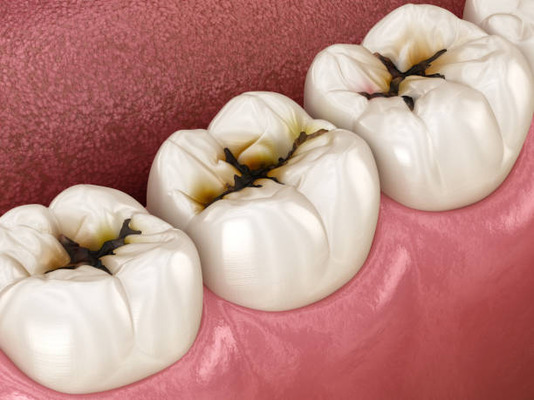Dental pulpitis is a common dental condition that involves inflammation of the tooth pulp, the soft tissue located in the center of the tooth. This inflammation can lead to varying degrees of pain and discomfort, ranging from mild to severe. Understanding the causes, types, symptoms, and treatment options for pulpitis is essential for maintaining oral health and preventing further complications.
Causes of Dental Pulpitis:
Several factors can contribute to the development of dental pulpitis:
- Untreated Tooth Decay: Untreated tooth decay is the most common cause of pulpitis. When bacteria penetrate the tooth enamel and dentin, they can reach the tooth pulp, leading to inflammation and infection.
- Trauma: Trauma to the tooth, such as a fracture or crack, can expose the tooth pulp to bacteria, causing inflammation and pulpitis.
- Dental Procedures: Dental procedures such as deep cavity fillings, root canal therapy, or tooth restoration can irritate the dental pulp, leading to inflammation and pulpitis in some cases.
- Gum Disease: Advanced gum disease can cause the gums to recede, exposing the tooth roots and increasing the risk of bacterial infection reaching the dental pulp.
Types of Dental Pulpitis:
There are several types of dental pulpitis, each with its own characteristics and symptoms:
- Acute Pulpitis: Acute pulpitis is characterized by sudden and severe pain in the affected tooth. It is often caused by extensive tooth decay or trauma and requires prompt tooth attention to alleviate symptoms and prevent further complications.
- Chronic Pulpitis: Chronic pulpitis develops gradually over time and is typically associated with persistent, low-grade pain in the affected tooth. It can result from untreated tooth decay, repeated dental procedures, or underlying systemic conditions.
- Reversible Pulpitis: Reversible pulpitis occurs when the tooth pulp becomes inflamed but is still capable of healing. Symptoms may include mild to moderate pain, sensitivity to hot or cold temperatures, and occasional discomfort while chewing. With prompt dental treatment, reversible toothache can often be resolved without the need for invasive procedures.
- Irreversible Pulpitis: Irreversible pulpitis occurs when the inflammation of the dental pulp is severe and irreversible. Symptoms may include intense, throbbing pain, sensitivity to temperature changes, swelling, and abscess formation. Without timely intervention, irreversible toothache can lead to the death of the dental pulp and the spread of infection to surrounding tissues.
Symptoms of Dental Pulpitis:
The symptoms of dental pulpitis can vary depending on the type and severity of the condition. Common symptoms may include:
- Persistent toothache
- Sensitivity to hot or cold temperatures
- Pain while chewing or biting
- Swelling of the gums or face
- Pus or discharge around the affected tooth
- Foul taste or odor in the mouth
Pulpitis Pain at Night:
Many people with dental pulpitis experience worsening pain at night, as lying down can increase blood flow to the affected tooth, exacerbating inflammation and discomfort. Additionally, changes in posture during sleep may put pressure on the affected tooth, leading to increased pain and difficulty sleeping.
Treatment of Dental Pulpitis:
The treatment of dental pulpitis depends on the type and severity of the condition. In general, the goals of treatment are to alleviate pain, eliminate infection, and preserve the tooth whenever possible. Treatment options may include:
- Root Canal Therapy: Root canal therapy is a common treatment for irreversible pulpitis and involves removing the infected or inflamed dental pulp from the tooth’s interior. The tooth is then cleaned, disinfected, and sealed to prevent further infection.
- Extraction: In cases of severe pulpitis where the tooth cannot be saved, extraction may be necessary to prevent the spread of infection to surrounding teeth and tissues.
- Pulpotomy: In cases of reversible pulpitis in children, a pulpotomy may be performed to remove the inflamed portion of the dental pulp while preserving the vitality of the remaining tissue.
Home Treatment for Dental Pulpitis:
While home remedies may provide temporary relief from the symptoms of tooth pulp infection, they are not a substitute for professional dental care. However, some home treatment options that may help alleviate pain and discomfort include:
- Over-the-counter pain relievers
- Avoiding foods and beverages that are extremely hot or cold
- Rinsing the mouth with warm salt water
- Applying a cold compress to the affected area
Conclusion:
Dental pulpitis is a common dental condition that can cause significant pain and discomfort if left untreated. By understanding the causes, types, symptoms, and treatment options for pulp, individuals can take proactive steps to maintain their oral health and seek timely dental care when needed. Prompt intervention is crucial for alleviating symptoms, preventing complications, and preserving the affected tooth whenever possible. If you experience persistent tooth pain or other symptoms of toothache, consult with a dentist for proper evaluation and treatment.

